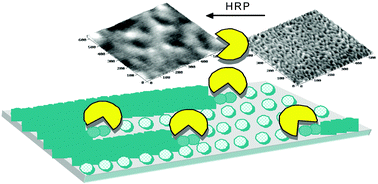Citation:
Abstract:
In this contribution we report on an in situ enzymatic self-assembly of a polyaniline (PAN) monolayer on modified hydroxyl-terminated surfaces. The consecutive assembly steps consist of a chemical deposition of 3-aminopropyltrimethoxysilane (APT) as a coupling agent with a positively-charged amine end group. The next step involved an electrostatic adhesion of sulfonated polystyrene (SPS) followed by electrostatic adhesion of anilinium. In situ enzymatic polymerization of the anilinium monolayer took place using horseradish peroxidase (HRP) enzyme and its substrate H2O2. The assembly steps were characterized by variable angle spectroscopic ellipsometry (VASE), UV-Vis-NIR spectroscopy, contact angle measurements, X-ray photoelectron spectroscopy (XPS), contact potential difference (CPD) and scanning force microscopy (SFM). The SFM measurements were divided between ex situ analysis in which morphology of the obtained layers was determined, and in situ analysis which provided information on the dynamic process of the enzymatic polymerization.


